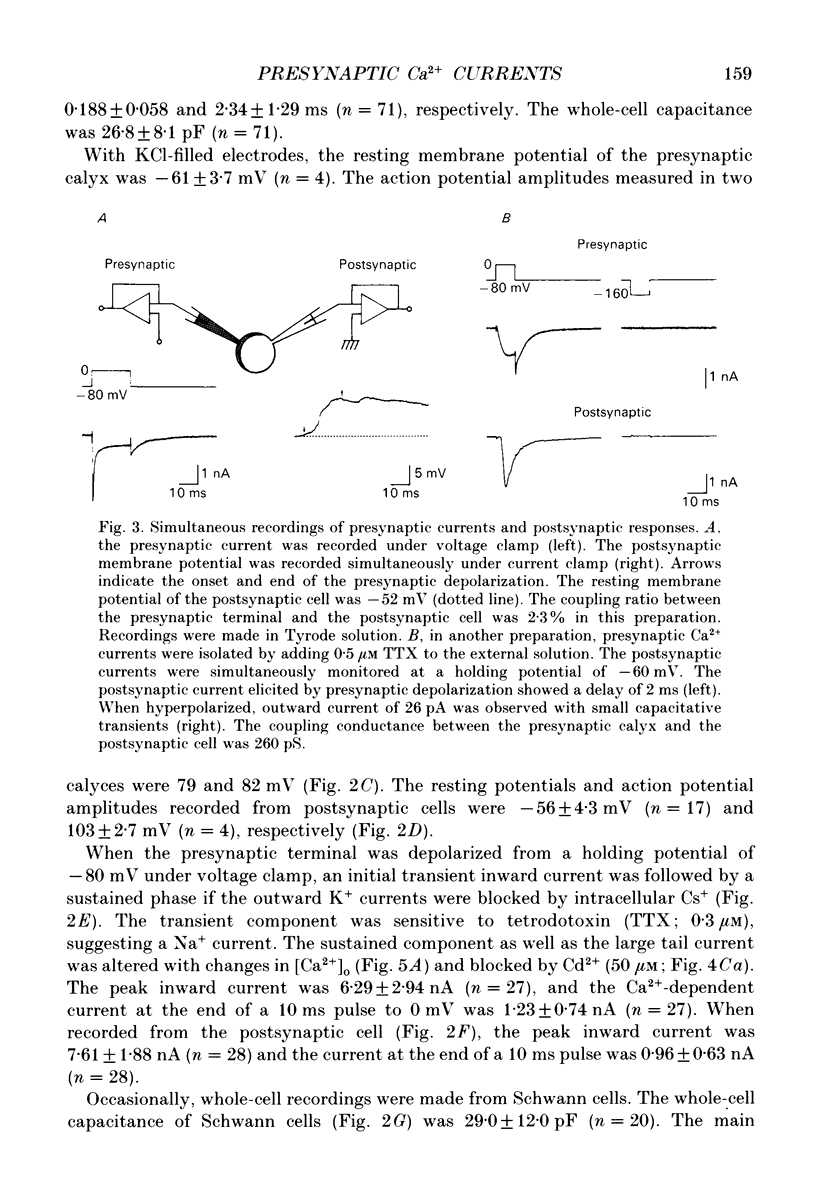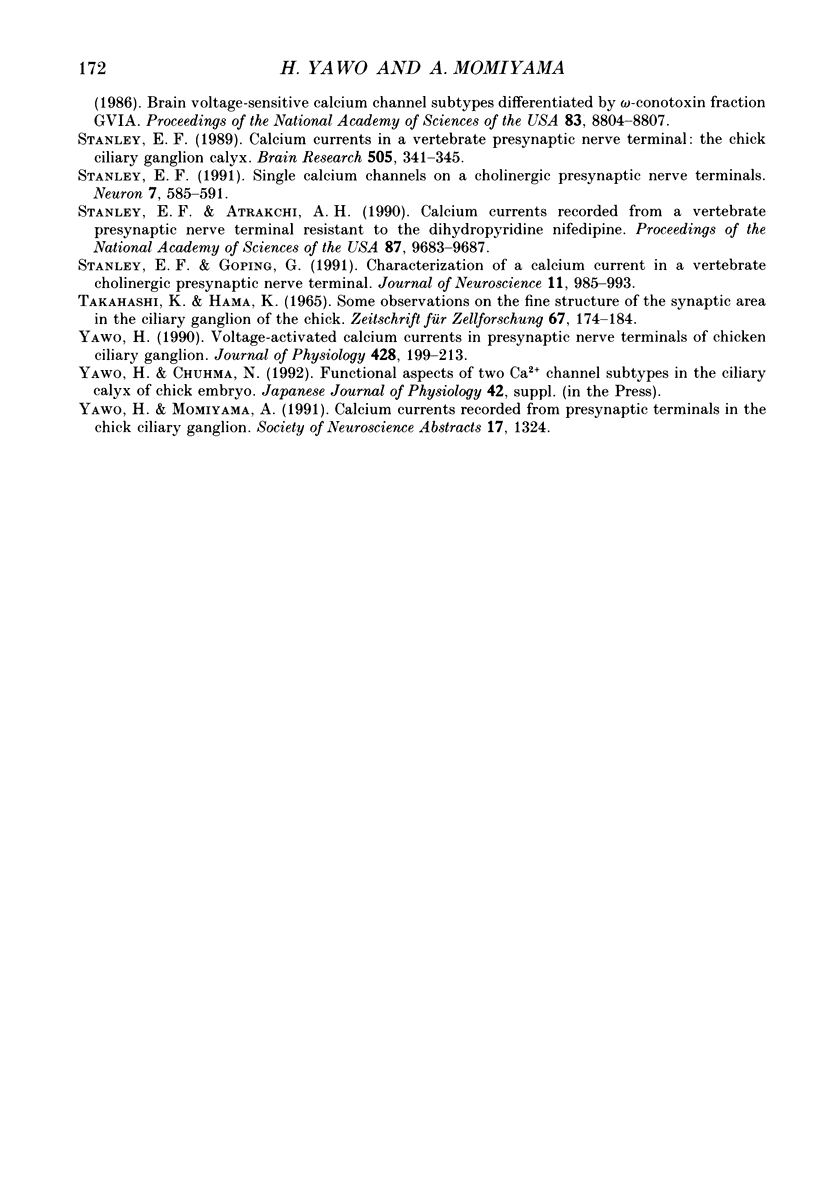Abstract
1. Presynaptic nerve terminals of ciliary ganglia of the chick embryo were identified by the accumulation of dextran-tetramethylrhodamine applied to the cut end of the oculomotor nerve. Ca2+ currents were then recorded from the identified nerve terminals. 2. Whole-cell recordings were carried out simultaneously from a presynaptic terminal and its postsynaptic cell. The generation of presynaptic Ca2+ currents induced a postsynaptic response with a short delay. Electrical coupling was present in eight of fifteen pairs. The coupling ratio did not exceed 5%. 3. High-threshold Ba2+ currents were observed in presynaptic terminals without any evidence for the presence of low-threshold Ca2+ channels. The Ba2+ current was completely blocked by 50 microM Cd2+. 4. The presynaptic Ca2+ current induced by a long depolarizing pulse showed inactivation, but this inactivation was diminished when Ca2+ was replaced with Ba2+. 5. The presynaptic Ba2+ current was insensitive to dihydropyridines (DHPs). omega-Conotoxin GVIA (omega CgTX) suppressed a large fraction of the Ba2+ current irreversibly. About 10% of the Ba2+ current was resistant to both DHPs and omega CgTX. 6. The omega CgTX-sensitive component was not sensitive to changes in the holding potential between -120 and -50 mV. The omega CgTX-resistant component tended to be inactivated at depolarized holding potentials. 7. In some perisynaptic Schwann cells, small Ca2+ currents were observed. These Ca2+ currents increased monotonically with depolarization. 8. Only high-threshold Ca2+ channel currents were observed in postsynaptic ciliary cells. Exposure to 50 microM Cd2+ completely abolished the Ca2+ current. 9. About 25% of the Ba2+ currents were blocked by nifedipine (10 microM) in ciliary cells. The nifedipine-resistant component was partly blocked by omega CdTX (10 microM) leaving a small component (about 20%) which was resistant to both nifedipine and omega CgTX. 10. In ciliary cells, the fraction of Ba2+ currents blocked by omega CgTX was not affected by the presence or absence of nifedipine. Similarly, nifedipine blocked the Ba2+ currents to the same extent whether omega CgTX was present or not. The Ba2+ currents potentiated by Bay K 8644 were eliminated by nifedipine. 11. It is concluded that the presynaptic terminal of chick ciliary ganglion did not possess DHP-sensitive Ca2+ channels in contrast with the postsynaptic cell. Two subpopulations of presynaptic Ca2+ channels were distinguishable by their sensitivity to omega CgTX and membrane potential.
Full text
PDF



















Images in this article
Selected References
These references are in PubMed. This may not be the complete list of references from this article.
- Aosaki T., Kasai H. Characterization of two kinds of high-voltage-activated Ca-channel currents in chick sensory neurons. Differential sensitivity to dihydropyridines and omega-conotoxin GVIA. Pflugers Arch. 1989 Jun;414(2):150–156. doi: 10.1007/BF00580957. [DOI] [PubMed] [Google Scholar]
- Artalejo C. R., Perlman R. L., Fox A. P. Omega-conotoxin GVIA blocks a Ca2+ current in bovine chromaffin cells that is not of the "classic" N type. Neuron. 1992 Jan;8(1):85–95. doi: 10.1016/0896-6273(92)90110-y. [DOI] [PubMed] [Google Scholar]
- Augustine G. J., Charlton M. P., Smith S. J. Calcium action in synaptic transmitter release. Annu Rev Neurosci. 1987;10:633–693. doi: 10.1146/annurev.ne.10.030187.003221. [DOI] [PubMed] [Google Scholar]
- Augustine G. J., Eckert R. Divalent cations differentially support transmitter release at the squid giant synapse. J Physiol. 1984 Jan;346:257–271. doi: 10.1113/jphysiol.1984.sp015020. [DOI] [PMC free article] [PubMed] [Google Scholar]
- Brigant J. L., Mallart A. Presynaptic currents in mouse motor endings. J Physiol. 1982 Dec;333:619–636. doi: 10.1113/jphysiol.1982.sp014472. [DOI] [PMC free article] [PubMed] [Google Scholar]
- Cantino D., Mugnaini E. The structural basis for electrotonic coupling in the avian ciliary ganglion. A study with thin sectioning and freeze-fracturing. J Neurocytol. 1975 Oct;4(5):505–536. doi: 10.1007/BF01351535. [DOI] [PubMed] [Google Scholar]
- Charlton M. P., Augustine G. J. Classification of presynaptic calcium channels at the squid giant synapse: neither T-, L- nor N-type. Brain Res. 1990 Aug 13;525(1):133–139. doi: 10.1016/0006-8993(90)91328-e. [DOI] [PubMed] [Google Scholar]
- DE LORENZO A. J. The fine structure of synapses in the ciliary ganglion of the chick. J Biophys Biochem Cytol. 1960 Feb;7:31–36. doi: 10.1083/jcb.7.1.31. [DOI] [PMC free article] [PubMed] [Google Scholar]
- Dryer S. E., Dourado M. M., Wisgirda M. E. Properties of Ca2+ currents in acutely dissociated neurons of the chick ciliary ganglion: inhibition by somatostatin-14 and somatostatin-28. Neuroscience. 1991;44(3):663–672. doi: 10.1016/0306-4522(91)90086-4. [DOI] [PubMed] [Google Scholar]
- Eckert R., Chad J. E. Inactivation of Ca channels. Prog Biophys Mol Biol. 1984;44(3):215–267. doi: 10.1016/0079-6107(84)90009-9. [DOI] [PubMed] [Google Scholar]
- Epstein M. L., Davis J. P., Gellman L. E., Lamb J. R., Dahl J. L. Cholinergic neurons of the chicken ciliary ganglion contain somatostatin. Neuroscience. 1988 Jun;25(3):1053–1060. doi: 10.1016/0306-4522(88)90058-9. [DOI] [PubMed] [Google Scholar]
- Fox A. P., Nowycky M. C., Tsien R. W. Kinetic and pharmacological properties distinguishing three types of calcium currents in chick sensory neurones. J Physiol. 1987 Dec;394:149–172. doi: 10.1113/jphysiol.1987.sp016864. [DOI] [PMC free article] [PubMed] [Google Scholar]
- Fox A. P., Nowycky M. C., Tsien R. W. Single-channel recordings of three types of calcium channels in chick sensory neurones. J Physiol. 1987 Dec;394:173–200. doi: 10.1113/jphysiol.1987.sp016865. [DOI] [PMC free article] [PubMed] [Google Scholar]
- Fujiwara T., Nagakuro C. Three-dimensional structure of the presynaptic nerve ending in the ciliary ganglion of the chick embryo: a scanning electron microscopic study. Neurosci Lett. 1989 Mar 27;98(2):125–128. doi: 10.1016/0304-3940(89)90496-5. [DOI] [PubMed] [Google Scholar]
- Gray D. B., Zelazny D., Manthay N., Pilar G. Endogenous modulation of ACh release by somatostatin and the differential roles of Ca2+ channels. J Neurosci. 1990 Aug;10(8):2687–2698. doi: 10.1523/JNEUROSCI.10-08-02687.1990. [DOI] [PMC free article] [PubMed] [Google Scholar]
- Gundersen C. B., Katz B., Miledi R. The antagonism between botulinum toxin and calcium in motor nerve terminals. Proc R Soc Lond B Biol Sci. 1982 Oct 22;216(1204):369–376. doi: 10.1098/rspb.1982.0080. [DOI] [PubMed] [Google Scholar]
- Hamill O. P., Marty A., Neher E., Sakmann B., Sigworth F. J. Improved patch-clamp techniques for high-resolution current recording from cells and cell-free membrane patches. Pflugers Arch. 1981 Aug;391(2):85–100. doi: 10.1007/BF00656997. [DOI] [PubMed] [Google Scholar]
- Johnson D. A., Pilar G. The release of acetylcholine from post-ganglionic cell bodies in response to depolarization. J Physiol. 1980 Feb;299:605–619. doi: 10.1113/jphysiol.1980.sp013144. [DOI] [PMC free article] [PubMed] [Google Scholar]
- Katz B., Miledi R. The release of acetylcholine from nerve endings by graded electric pulses. Proc R Soc Lond B Biol Sci. 1967 Jan 31;167(1006):23–38. doi: 10.1098/rspb.1967.0011. [DOI] [PubMed] [Google Scholar]
- Keyser D. O., Alger B. E. Arachidonic acid modulates hippocampal calcium current via protein kinase C and oxygen radicals. Neuron. 1990 Oct;5(4):545–553. doi: 10.1016/0896-6273(90)90092-t. [DOI] [PubMed] [Google Scholar]
- Landmesser L., Pilar G. The onset and development of transmission in the chick ciliary ganglion. J Physiol. 1972 May;222(3):691–713. doi: 10.1113/jphysiol.1972.sp009822. [DOI] [PMC free article] [PubMed] [Google Scholar]
- Llinás R., Steinberg I. Z., Walton K. Presynaptic calcium currents in squid giant synapse. Biophys J. 1981 Mar;33(3):289–321. doi: 10.1016/S0006-3495(81)84898-9. [DOI] [PMC free article] [PubMed] [Google Scholar]
- Llinás R., Sugimori M., Lin J. W., Cherksey B. Blocking and isolation of a calcium channel from neurons in mammals and cephalopods utilizing a toxin fraction (FTX) from funnel-web spider poison. Proc Natl Acad Sci U S A. 1989 Mar;86(5):1689–1693. doi: 10.1073/pnas.86.5.1689. [DOI] [PMC free article] [PubMed] [Google Scholar]
- MARTIN A. R., PILAR G. AN ANALYSIS OF ELECTRICAL COUPLING AT SYNAPSES IN THE AVIAN CILIARY GANGLION. J Physiol. 1964 Jun;171:454–475. doi: 10.1113/jphysiol.1964.sp007390. [DOI] [PMC free article] [PubMed] [Google Scholar]
- MARTIN A. R., PILAR G. DUAL MODE OF SYNAPTIC TRANSMISSION IN THE AVIAN CILIARY GANGLION. J Physiol. 1963 Sep;168:443–463. doi: 10.1113/jphysiol.1963.sp007202. [DOI] [PMC free article] [PubMed] [Google Scholar]
- Martin A. R., Patel V., Faille L., Mallart A. Presynaptic calcium currents recorded from calyciform nerve terminals in the lizard ciliary ganglion. Neurosci Lett. 1989 Oct 23;105(1-2):14–18. doi: 10.1016/0304-3940(89)90004-9. [DOI] [PubMed] [Google Scholar]
- Marwitt R., Pilar G., Weakly J. N. Characterization of two ganglion cell populations in avian ciliary ganglia. Brain Res. 1971 Jan 22;25(2):317–334. doi: 10.1016/0006-8993(71)90441-0. [DOI] [PubMed] [Google Scholar]
- McCleskey E. W., Fox A. P., Feldman D. H., Cruz L. J., Olivera B. M., Tsien R. W., Yoshikami D. Omega-conotoxin: direct and persistent blockade of specific types of calcium channels in neurons but not muscle. Proc Natl Acad Sci U S A. 1987 Jun;84(12):4327–4331. doi: 10.1073/pnas.84.12.4327. [DOI] [PMC free article] [PubMed] [Google Scholar]
- Mori Y., Friedrich T., Kim M. S., Mikami A., Nakai J., Ruth P., Bosse E., Hofmann F., Flockerzi V., Furuichi T. Primary structure and functional expression from complementary DNA of a brain calcium channel. Nature. 1991 Apr 4;350(6317):398–402. doi: 10.1038/350398a0. [DOI] [PubMed] [Google Scholar]
- Olivera B. M., Gray W. R., Zeikus R., McIntosh J. M., Varga J., Rivier J., de Santos V., Cruz L. J. Peptide neurotoxins from fish-hunting cone snails. Science. 1985 Dec 20;230(4732):1338–1343. doi: 10.1126/science.4071055. [DOI] [PubMed] [Google Scholar]
- Pilar G., Vaughan P. C. Electrophysiological investigations of the pigeon iris neuromuscular junctions. Comp Biochem Physiol. 1969 Apr;29(1):51–72. doi: 10.1016/0010-406x(69)91725-3. [DOI] [PubMed] [Google Scholar]
- Plummer M. R., Logothetis D. E., Hess P. Elementary properties and pharmacological sensitivities of calcium channels in mammalian peripheral neurons. Neuron. 1989 May;2(5):1453–1463. doi: 10.1016/0896-6273(89)90191-8. [DOI] [PubMed] [Google Scholar]
- Regan L. J., Sah D. W., Bean B. P. Ca2+ channels in rat central and peripheral neurons: high-threshold current resistant to dihydropyridine blockers and omega-conotoxin. Neuron. 1991 Feb;6(2):269–280. doi: 10.1016/0896-6273(91)90362-4. [DOI] [PubMed] [Google Scholar]
- Stanley E. F., Atrakchi A. H. Calcium currents recorded from a vertebrate presynaptic nerve terminal are resistant to the dihydropyridine nifedipine. Proc Natl Acad Sci U S A. 1990 Dec;87(24):9683–9687. doi: 10.1073/pnas.87.24.9683. [DOI] [PMC free article] [PubMed] [Google Scholar]
- Stanley E. F. Calcium currents in a vertebrate presynaptic nerve terminal: the chick ciliary ganglion calyx. Brain Res. 1989 Dec 29;505(2):341–345. doi: 10.1016/0006-8993(89)91465-0. [DOI] [PubMed] [Google Scholar]
- Stanley E. F., Goping G. Characterization of a calcium current in a vertebrate cholinergic presynaptic nerve terminal. J Neurosci. 1991 Apr;11(4):985–993. doi: 10.1523/JNEUROSCI.11-04-00985.1991. [DOI] [PMC free article] [PubMed] [Google Scholar]
- Stanley E. F. Single calcium channels on a cholinergic presynaptic nerve terminal. Neuron. 1991 Oct;7(4):585–591. doi: 10.1016/0896-6273(91)90371-6. [DOI] [PubMed] [Google Scholar]
- Takahashi K., Hama K. Some observations on the fine structure of the synaptic area in the ciliary ganglion of the chick. Z Zellforsch Mikrosk Anat. 1965 Jul 15;67(2):174–184. doi: 10.1007/BF00344467. [DOI] [PubMed] [Google Scholar]
- Yawo H. Voltage-activated calcium currents in presynaptic nerve terminals of the chicken ciliary ganglion. J Physiol. 1990 Sep;428:199–213. doi: 10.1113/jphysiol.1990.sp018207. [DOI] [PMC free article] [PubMed] [Google Scholar]




